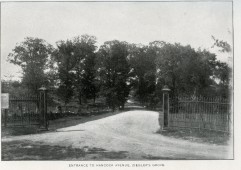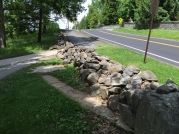 Construction is beginning in mid-July 2016 on $1.5 million dollar project to rehabilitate Cemetery Ridge at Gettysburg National Military Park. The nonprofit Gettysburg Foundation will provide a grant of $900,000 to match National Park Service funding of $600,000 for this stewardship project. Click here for the latest news release.
Construction is beginning in mid-July 2016 on $1.5 million dollar project to rehabilitate Cemetery Ridge at Gettysburg National Military Park. The nonprofit Gettysburg Foundation will provide a grant of $900,000 to match National Park Service funding of $600,000 for this stewardship project. Click here for the latest news release.
This blog post will provide details for the historic features that will be returned to Cemetery Ridge, including moving some monuments to their original location. They were moved during the construction of the Cyclorama building, which has now been demolished.
The Hancock Avenue Entrance Gate – We will be rebuilding the Hancock Avenue entrance gates that were built in 1923. There were earlier gates of different designs. In 1882, the Gettysburg Battlefield Memorial Association created an opening in the stone wall on the west side of Taneytown Road for access to Hancock Avenue. The first version, in 1889, was a wood and wire gate. A later version, in 1896, included iron fencing (see photo) from the original fence that had

The 1896 version of the Hancock Avenue gate at Taneytown Road used pieces of the old Lafayette Square fence from Washington D.C.
surrounded Lafayette Square Park in Washington, D.C. – the same iron fencing that now forms the boundary between Evergreen Cemetery and the Soldiers’ National Cemetery. The park’s monument specialists have the majority of the historic stones need to rebuild the 1923 gateway.
Ziegler’s Grove – During Pickett’s Charge, the left flank of General Pettigrew’s division engaged Union forces in Ziegler’s Grove. Because Battery I, 1st U.S. Artillery was located in Ziegler’s Grove it was heavily shelled during the pre-assault bombardment, inflicting numerous casualties on the battery’s infantry support, the 108th New York, and other nearby infantry units. This project will allow us to replant the
missing portion of Ziegler’s Grove. We plan to plant approximately 125 trees including Black Cherry, Shagbark Hickory, Black Gum, White Oak, Red Oak, Tulip Poplar and Honey Locust.
Ziegler’s Ravine – Documentation for reestablishing this ravine comes from a number of sources, including a grading plan in the National Park Service files showing the area before the Cyclorama building parking lot was developed. In addition, archaeology helped establish the exact location of a portion of the original Hancock Avenue during testing completed by the park when we replaced a water line extension in 2006.

Looking toward the National Cemetery along the old commemorative walkway, this shows the dip known as Ziegler’s Ravine. Hancock Avenue cuts across the far side of the ravine. The 88th Pa. Marker, in its original location, is on the left.
The profile of Ziegler’s Ravine will be especially noticeable to those driving on Hancock Avenue as the road will proceed down a dramatic dip and then come back up for an approximately six foot change in elevation. We will also rebuild some stone walls near Hancock Avenue and a long commemorative walkway that was surfaced with crushed stone.
The Monuments – In 1960 when the park started construction for the Cyclorama building, a number of monuments in this area were
moved, some only a few feet. In September 2014, park staff returned the granite Battery F, 5th US Artillery monument to its original location. The original spot had been completely covered over by the Cyclorama building.
12th Massachusetts Infantry Position Marker (Webster Regiment) – This granite marker was erected in September 1885 to indicate the line occupied by the regiment in Ziegler’s Grove while protecting the ravine and the Union center on the night of July 1 and during July 3. The marker was removed in 1961-1962 during grading and development of the Cyclorama building, and relocated to a slightly different location within the parking area by NPS.
88th Pennsylvania Infantry Position Marker – This is one of three monuments erected by the survivors’ association of the regiment and designates the position held by the 88th Pennsylvania on July 1 – 2 and at the close of the fighting on July 4. The granite marker, about two feet in height, was mounted on a large boulder within the northwest corner of Ziegler’s Grove. Erected in the summer of 1883, this is one of the oldest regimental markers in the park. The monument and the boulder on which it is affixed were both relocated by NPS during the development of the Cyclorama building. The face of the boulder was broken off causing the granite marker to be reset.
1st Massachusetts Sharpshooters Position Marker – This position marker is located at the northwest corner of Ziegler’s Grove and consists of a granite marker about two feet in height onto which is affixed an aluminum narrative tablet. The marker, erected in 1913 at the request of company veterans, indicates the position occupied by these marksmen while defending Union batteries in Ziegler’s Grove. The marker was relocated during development and regrading of the Cyclorama

This photo was taken on May 20, 2015, at the site of the Hancock Avenue gate at Taneytown Road. The footing of the old stone gate is clearly visible today.
building grounds.
NPS Centennial – To prepare for its Centennial in 2016, the National Park Service is funding legacy projects that will preserve resources for the future. In March, the National Park Service launched “Find Your Park,” a national public awareness and education campaign celebrating the milestone centennial anniversary of the National Park Service in 2016 and setting the stage for its second century of service.
Previous Rehab work on Cemetery Ridge –

Before the Cyclorama building was constructed, there was a War Department observation tower at the site near the Brian farm, shown here on the right. This view of the Brian farm house shows post battle additions that have since been removed.
For six years, the Gettysburg Foundation has funded and implemented important earlier phases of the rehabilitation of Cemetery Ridge including demolition of the Visitor Center in 2009; demolition of the Cyclorama building in 2013; and removal and rehabilitation of the former Visitor Center parking lot site in 2014.
Timing – The project will be underway in July 2016 and will last about six months.
Thanks to Chris Gwinn and Jason Martz for the photos.
Katie Lawhon, Management Assistant, updated 7/7/16






Reblogged this on 9 Months for the Union.
On behalf of our Descendants of the 88th Pennsylvania Volunteer Infantry Regiment group we are very glad to see this project move forward. Would this work also include restoring Baxter’s Defense Works at Hancock Ave? Thanks
No, the plan does not include the restoration of any of Baxter’s brigade defensive works. They built/ dug/ stacked up some manner of protection but we don’t know enough about what they looked like and there is very little evidence to accurately restore this feature. Katie Lawhon
Hi Katie, thank you for the reply and sorry for the delay in response back to you.
Why is The Hancock Avenue entrance gates being restored to the battlefield ? I thought the goal was to restore the battlefield as it appeared in 1863 ? The gates were built in 1923.
Respectfully,
William
Pingback: Gettysburg: the Power of Partnership | The Blog of Gettysburg National Military Park
What does the Hancock Gate have to do with the battle? There was so much backing and support to have the old cyclorama building removed, so why the effort to have an earlier post battle structure rebuilt? Who knows maybe in a few hundred years there will be a move to have the old cyclorama building reconstructed. SMH
Maybe somebody’s friend needs the work?
Commemorative features on the Gettysburg battlefield are nationally significant and their preservation is a vital part of the mission of Gettysburg National Military Park which is:
Gettysburg National Military Park preserves, protects, and interprets for this and future generations, the resources associated with the 1863 Battle of Gettysburg during the American Civil War, the Soldiers’ National Cemetery, and their commemorations. The commemorative era defined in the park’s General Management Plan is 1863 to 1927, when veterans and survivors of the battle preserved the grounds of Gettysburg and created commemorative features that still define the park today.
With the work in the Ziegler’s grove area, I hope you will consider an Anniversary Battlewalk in 2017 on the Union defense actions against Picket’s Charge north of the Brien Farm including the Ziegler’s Grove area.
Are there any plans to restore McPherson’s Woods to it’s 1863 state?
Great question! The park is undertaking a review of landscape management with our battlefield rehabilitation project, and the woods know as “McPherson’s Woods” (actually part of the John Herbst farm adjacent to McPherson’s property) is included in that management study. We have found through the experience of landscape rehabilitation that certain methods have worked well while others have not. Managing the open nature of those woods will require more intense labor and ground cover maintenance on a yearly basis and will be addressed as the rehabilitation project continues. Thanks for asking!
So where is the Cyclorama painting at now?
The Cyclorama painting, restored to its earliest appearance with a foreground, is now on exhibit in the Gettysburg National Military Park Museum and Visitor Center, 1195 Baltimore Pike.
JUST LEFT gETTYSBURG AFTER THREE DAYS TOURING , We go down 5 to 6 times a year . HATS OFF TO UP GRADING THE BATTLE FIELD AS IT WAS IM ALL FOR IT AND SUPPORT YOU AS WELL .
iS IT POSSIBLE TO OBTAIN A COPY OF THE PHOTOS YOU USED IN YOUR BLOG FOR A PRESENTATION HERE IN THE BUFFALO NY AREA TO KEEP PEOPLE INFORMED AS WELL . THESE PRESENTATIONS WOULD BE AT NON PRO FIT TALKS AS ROUND TABLE HISTORICAL SOC ,MUSEUMS ETC ? OUR WAY OF HELPING I WOULD COVER ALL COSTS
Tom, you can use any of the images that appear in our blog. Just right click and save them as images.